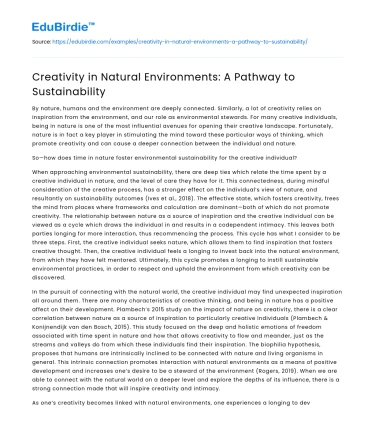By nature, humans and the environment are deeply connected. Similarly, a lot of creativity relies on inspiration from the environment, and our role as environmental stewards. For many creative individuals, being in nature is one of the most influential avenues for opening their creative landscape. Fortunately, nature is in fact a key player in stimulating the mind toward these particular ways of thinking, which promote creativity and can cause a deeper connection between the individual and nature.
So—how does time in nature foster environmental sustainability for the creative individual?
Save your time!
We can take care of your essay
- Proper editing and formatting
- Free revision, title page, and bibliography
- Flexible prices and money-back guarantee
When approaching environmental sustainability, there are deep ties which relate the time spent by a creative individual in nature, and the level of care they have for it. This connectedness, during mindful consideration of the creative process, has a stronger effect on the individual’s view of nature, and resultantly on sustainability outcomes (Ives et al., 2018). The effective state, which fosters creativity, frees the mind from places where frameworks and calculation are dominant—both of which do not promote creativity. The relationship between nature as a source of inspiration and the creative individual can be viewed as a cycle which draws the individual in and results in a codependent intimacy. This leaves both parties longing for more interaction, thus recommencing the process. This cycle has what I consider to be three steps. First, the creative individual seeks nature, which allows them to find inspiration that fosters creative thought. Then, the creative individual feels a longing to invest back into the natural environment, from which they have felt mentored. Ultimately, this cycle promotes a longing to instill sustainable environmental practices, in order to respect and uphold the environment from which creativity can be discovered.
In the pursuit of connecting with the natural world, the creative individual may find unexpected inspiration all around them. There are many characteristics of creative thinking, and being in nature has a positive affect on their development. Plambech’s 2015 study on the impact of nature on creativity, there is a clear correlation between nature as a source of inspiration to particularly creative individuals (Plambech & Konijnendijk van den Bosch, 2015). This study focused on the deep and holistic emotions of freedom associated with time spent in nature and how that allows creativity to flow and meander, just as the streams and valleys do from which these individuals find their inspiration. The biophilia hypothesis, proposes that humans are intrinsically inclined to be connected with nature and living organisms in general. This intrinsic connection promotes interaction with natural environments as a means of positive development and increases one’s desire to be a steward of the environment (Rogers, 2019). When we are able to connect with the natural world on a deeper level and explore the depths of its influence, there is a strong connection made that will inspire creativity and intimacy.
As one’s creativity becomes linked with natural environments, one experiences a longing to devote time and investment back into the environment. The further one walks into natural environments with a recognition of the influence it has on them, the closer their relationship with nature becomes. Exposure most often leads to connection, thus the more time spent in the natural world, feeding off of its positive attributes, the greater amount of care one will have for nature. In a study done on individuals reconnecting with natural environments for the purpose of encountering sustainability, the authors found that those with stronger connections with the natural environment had higher emotional and philosophical “leverage points.” These individuals also considered sustainability to be highly important (Ives et al., 2018). These “leverage points” range from a shallow connection, such as a superficially motivated material connection, to a deeper philosophical connection between nature and the creative individual. These positive emotions draw individuals closer to nature, as a single unified system and as something to be in intimate relationship with, which increases the individual’s desire to care for the wellbeing of the environment. When people are encouraged to foster a stronger connection with the environment, transformative growth can occur in their life. They will often invest that growth back into the environment from which they were inspired.
How then can we as creative individuals move forward?
With this cycle in mind, recognition of the creative influence found in natural environments is of critical importance when considering both creative processes and sustainability practices. When the creative individual seeks inspiration and influence, they can find it in natural environments. Likewise, the environment is able to find a steward in the creative individual. Biophilic in nature, the relationship that is formed from this practice benefits both the individual and the natural environment with which they are connected. Relating back to the aforementioned cycle, I propose that each of us takes the time to consider where on this cycle we may fall and how we are to set forth in upholding our creativity and environment within the cycle. Where no recognition can currently be made in identifying one’s location on this cycle, there seems to be a clear understanding of the benefits that await the creative individual and their environment in taking the next step.






 Stuck on your essay?
Stuck on your essay?

